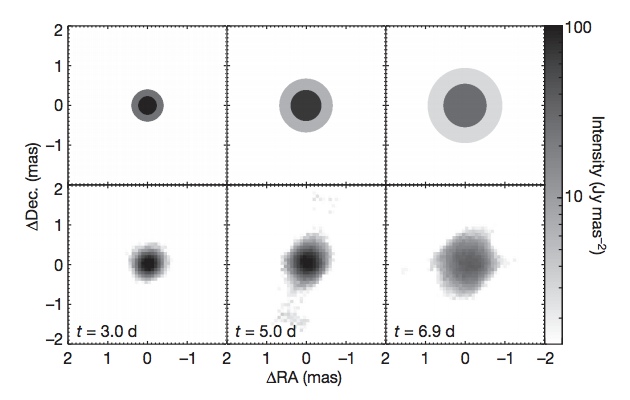Artists depiction of white dwarf about to go nova. Image:
Casey Reed/NASA.
"Giant cosmic fireball" isn't usually the first thing that comes to mind when considering a white dwarf. These small, dense stars are fossils left over from the supernovae of larger main-sequence stars, and they usually spend their post-explosion years slowly wilting into black dwarfs.But some white dwarfs get a second chance to shine, and astronomers based out of Georgia State University were able to capture this rare event—called a nova—in unprecedented detail. Their study, led by Gail Schaefer and published in Nature today, includes the first images ever taken of the early "fireball stage" of novae, revealing the never-before-seen dynamics of these explosions.The nova the team imaged is called Nova Delphini 2013, and it's located about 14,800 light years away in the constellation Delphinus. It was discovered on August 14, 2013 by amateur astronomer Koichi Itagak, and was widely observed as it brightened, reaching a peak magnitude of 4.3 on August 16—bright enough to be seen with the naked eye.As soon as they caught wind of the discovery, Schaefer and her colleagues trained GSU's array of telescopes at the Center for High Angular Resolution Astronomy (CHARA) towards the nova. "We began with an intensive observing campaign to measure the size of the nova with the CHARA Array," the authors wrote in the study. "Our observations began within 15 hours of the discovery and within 24 hours of the detonation itself," they continued. "We measured the size of the expanding ejecta as the nova rose to peak brightness and continued monitoring it for a total of 27 nights between August 15 2013 to September 26."The quick reaction time enabled the team to capture an unprecedented glimpse into the expanding fireball stage of a nova explosion. The nova itself was triggered by the white dwarf accumulating hydrogen gas runoff from a normal, main-sequence companion star. Though its hydrogen shell was only about 650 feet deep, the monumental surface gravity of the white dwarf was enough to kickstart thermonuclear fusion in the shell's lower layers.That's the cosmic equivalent of throwing a lit match into a vat of gasoline. True to form, it detonated the white dwarf in a violent fireball that expanded for weeks. When the team first began observing, the star had expanded to about the size of Earth's orbit. By the time they ceased observations, it had steadily grown to the size of Neptune's orbit.In addition to measuring the scope of these novae, the images also revealed that they are more complicated than previously assumed. The first day after detonation produced a uniform explosion of ejected material, but by the second day, irregularities began to form that defined the development of the fireball. They incorporated the new data into an updated explosion model for these rare cosmic events.Post-fireball, white dwarfs typically cool down and begin gathering stellar material again, potentially resulting in recurrent novae every few decades or so. Perhaps Nova Delphinus 2013 falls into this category—in which case, last year's spectacular fireball will not be the last we see of it. Let's hope it breaks its way all the way into 3.0-level magnitude next time.
"Our observations began within 15 hours of the discovery and within 24 hours of the detonation itself," they continued. "We measured the size of the expanding ejecta as the nova rose to peak brightness and continued monitoring it for a total of 27 nights between August 15 2013 to September 26."The quick reaction time enabled the team to capture an unprecedented glimpse into the expanding fireball stage of a nova explosion. The nova itself was triggered by the white dwarf accumulating hydrogen gas runoff from a normal, main-sequence companion star. Though its hydrogen shell was only about 650 feet deep, the monumental surface gravity of the white dwarf was enough to kickstart thermonuclear fusion in the shell's lower layers.That's the cosmic equivalent of throwing a lit match into a vat of gasoline. True to form, it detonated the white dwarf in a violent fireball that expanded for weeks. When the team first began observing, the star had expanded to about the size of Earth's orbit. By the time they ceased observations, it had steadily grown to the size of Neptune's orbit.In addition to measuring the scope of these novae, the images also revealed that they are more complicated than previously assumed. The first day after detonation produced a uniform explosion of ejected material, but by the second day, irregularities began to form that defined the development of the fireball. They incorporated the new data into an updated explosion model for these rare cosmic events.Post-fireball, white dwarfs typically cool down and begin gathering stellar material again, potentially resulting in recurrent novae every few decades or so. Perhaps Nova Delphinus 2013 falls into this category—in which case, last year's spectacular fireball will not be the last we see of it. Let's hope it breaks its way all the way into 3.0-level magnitude next time.
Advertisement
